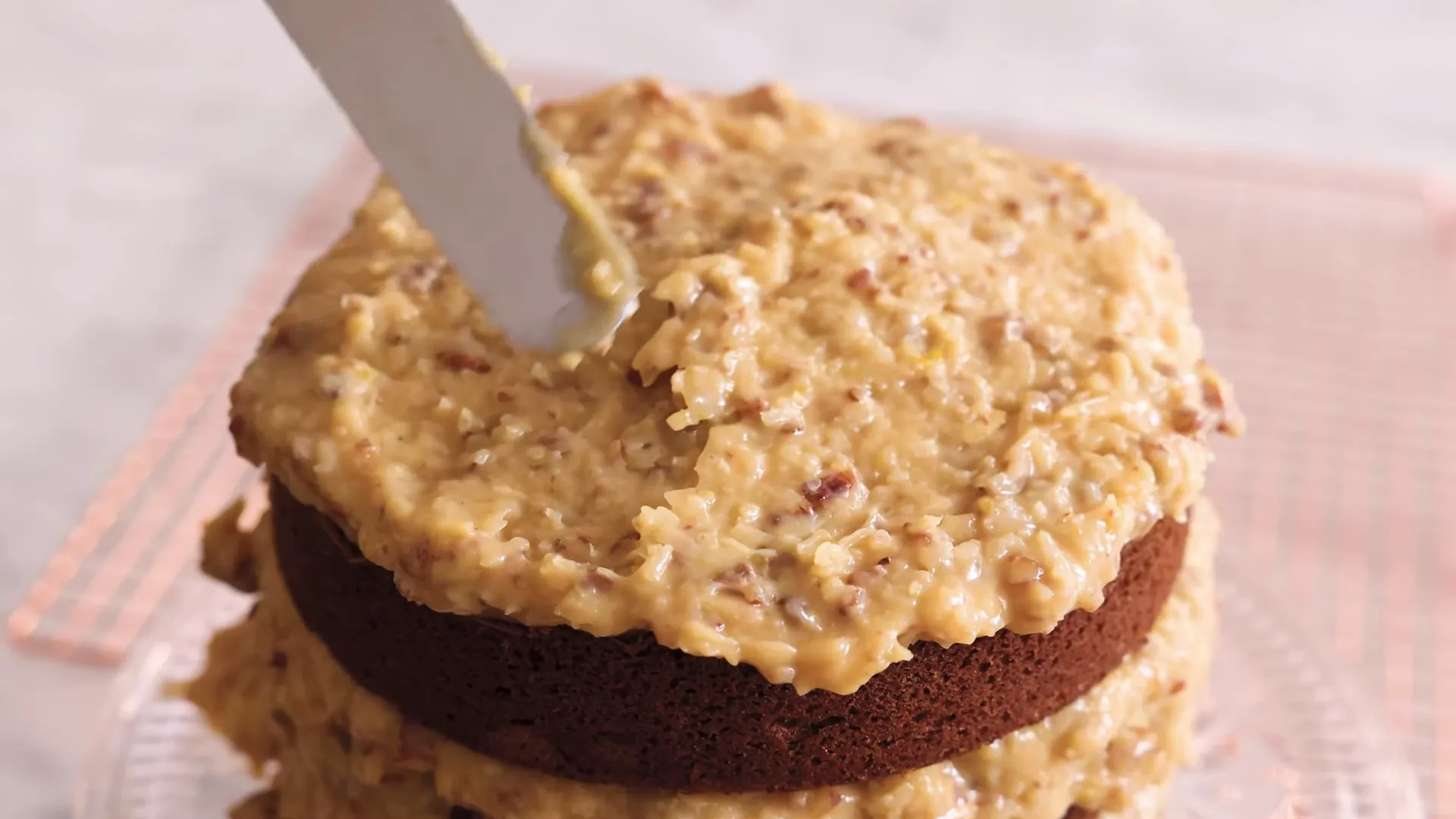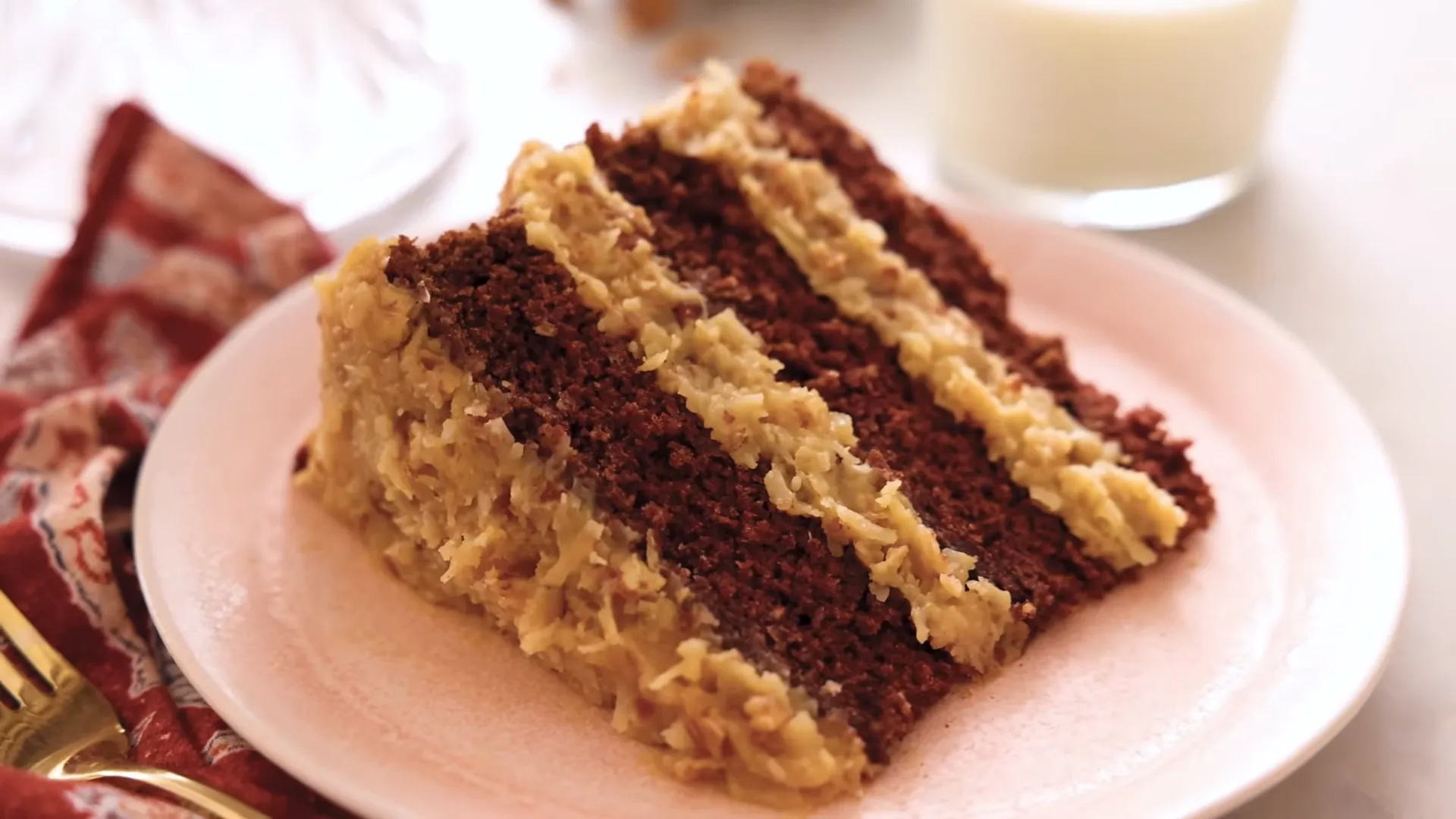Embarking on the journey of baking a classic dessert can be as thrilling as uncovering a cherished family secret. The Baker’s German Chocolate Cake Recipe stands as a testament to this thrill—a recipe that marries the richness of chocolate with the subtlety of coconut and pecans, promising a confection that’s both decadent and deeply satisfying. In this article, we’ll dive into the origins of this beloved cake, explore the unique elements that make it stand out, and emphasize the importance of choosing the right ingredients. Whether you’re a seasoned baker or a novice eager to create a masterpiece, this guide will equip you with the knowledge and tips to bake the perfect German Chocolate Cake.
Introduction to German Chocolate Cake
A Sweet Slice of History
Interestingly, the German Chocolate Cake doesn’t hail from Germany, as one might assume. Its roots trace back to 1852 when an American baker named Samuel German developed a dark baking chocolate for the Baker’s Chocolate Company. This chocolate’s unique sweetness and rich flavor profile laid the foundation for the cake we adore today. However, it wasn’t until a recipe published in a Dallas newspaper in 1957 that the cake gained national fame, becoming a staple in American baking.
What Makes Baker’s German Chocolate Cake Unique?
What sets the Baker’s German Chocolate Cake apart is its luxurious yet delicate texture and the harmonious blend of flavors. The cake’s structure, airy and light, serves as the perfect canvas for the rich coconut-pecan frosting—a hallmark of this confection. Unlike more traditional chocolate cakes, this dessert relies on the subtle sweetness and nuanced flavor of Baker’s German Sweet Chocolate, creating a taste that is sophisticated without being overwhelming.
The Importance of Ingredients
The secret to a flawless Baker’s German Chocolate Cake lies in the quality and specificity of the ingredients used. Opting for Baker’s German Sweet Chocolate is non-negotiable; its mild sweetness and creamy texture are irreplaceable. Equally crucial is the choice of fresh, high-quality eggs, butter, and buttermilk—each contributing to the cake’s moisture and richness. For the frosting, genuine evaporated milk, fresh coconut, and pecans ensure a topping that is as memorable as the cake itself.
In this exploration of the Baker’s German Chocolate Cake Recipe, we’ll not only uncover the layers of its history and uniqueness but also guide you through creating this exquisite dessert in your own kitchen. With each step, you’ll come closer to baking not just a cake, but an experience that celebrates the joy of baking and the sweetness of tradition.

Ingredients and Preparations
Essential Ingredients for Your Cake
The foundation of a remarkable Baker’s German Chocolate Cake is its ingredient list. Here, precision is key, ensuring each component harmonizes to create the final masterpiece. The cake itself requires:
- 1 package (4 ounces) of Baker’s German Sweet Chocolate, which infuses the cake with its signature flavor.
- 1 cup of butter, softened to room temperature for a tender crumb.
- 2 cups of sugar to sweeten the deal without overshadowing the chocolate’s nuanced notes.
- 4 eggs, separated, using the yolks for richness and whites for lightness.
- 1 teaspoon of vanilla extract, a background note that enhances chocolate’s depth.
- 2 cups of all-purpose flour, sifted, forming the cake’s structure without weighing it down.
- 1 teaspoon of baking soda, which reacts with the buttermilk to lift the cake.
- ½ teaspoon of salt, a subtle enhancer of all the cake’s flavors.
- 1 cup of buttermilk, adding moisture and tenderizing the cake’s crumb.
For the iconic coconut-pecan frosting:
- 1 ½ cups of evaporated milk, which provides the frosting its creamy base.
- 1 ½ cups of sugar, balancing the frosting’s sweetness with the filling’s richness.
- 4 egg yolks, slightly beaten, thickening the frosting to a lush consistency.
- ¾ cup of butter, which adds to the frosting’s velvety texture.
- 1 ½ teaspoons of vanilla extract, for an aromatic sweetness.
- 2 cups of shredded coconut and 1 ½ cups of chopped pecans, introducing a crunchy, nutty layer to the cake’s softness.
Prepping for Perfection
Before embarking on your baking adventure, ensuring you have the right tools at your disposal can make all the difference. Essential equipment includes:
- Three 9-inch round cake pans, lined with wax paper, to shape your cake layers perfectly.
- Mixing bowls, for separating wet and dry ingredients and beating egg whites to stiff peaks.
- A double boiler or a microwave-safe bowl for melting chocolate without burning it.
- A mixer, whether stand or hand-held, essential for creaming butter and sugar and for whipping egg whites.
- A saucepan, for concocting the sumptuous coconut-pecan frosting.
Gathering these ingredients and tools not only streamlines the baking process but also immerses you in the art of creating a Baker’s German Chocolate Cake that’s bound to impress. Each item, carefully chosen and prepared, contributes to a dessert that’s more than just a cake—it’s a celebration of craftsmanship and taste.
In the next section, we’ll dive into the heart of the baking process, guiding you through each step of crafting this iconic dessert. With the right ingredients and preparations in place, you’re well on your way to baking a cake that embodies the essence of celebration and indulgence.
Step-by-Step Recipe
Crafting the Cake Layers
- Preheat and Prepare: Begin by preheating your oven to 350°F (175°C). Line your 9-inch round cake pans with wax paper for easy release after baking.
- Melting Chocolate: Melt the Baker’s German Sweet Chocolate in a double boiler or microwave-safe bowl with ½ cup boiling water. Stir until smooth and let cool.
- Creaming Butter and Sugar: In a large mixing bowl, cream together 1 cup of butter and 2 cups of sugar until light and fluffy. This step is crucial for incorporating air into your batter.
- Egg Yolks and Vanilla: Beat in the egg yolks, one at a time, then stir in the vanilla extract and the cooled chocolate mixture.
- Sifting Dry Ingredients: Sift together the flour, baking soda, and salt. Gradually beat into the creamed mixture alternately with the buttermilk, starting and ending with the flour mixture.
- Whipping Egg Whites: In a separate bowl, beat the egg whites until stiff peaks form. Gently fold the egg whites into the batter, ensuring not to deflate them. This is the secret to the cake’s lightness.
- Baking: Divide the batter evenly among the prepared pans. Bake for 30-35 minutes or until a toothpick inserted into the center comes out clean. Allow the cakes to cool in pans for 15 minutes, then turn out onto wire racks to cool completely.
The Coconut-Pecan Frosting
- Combine Ingredients: In a saucepan, combine evaporated milk, sugar, slightly beaten egg yolks, and butter. Cook over medium heat, stirring constantly until the mixture thickens and bubbles. Remove from heat.
- Add Flavor: Stir in the vanilla extract, shredded coconut, and chopped pecans. Let the frosting cool until it reaches a spreadable consistency.
- Frost the Cake: Once the cake layers are completely cool, spread the frosting between layers, on top, and around the sides of the cake. The creamy frosting paired with the light, chocolatey layers creates a harmonious blend of textures and flavors.
Baking Tips and Tricks
- Melting Chocolate: To avoid scorching the chocolate, melt it gently and keep stirring. If using a microwave, do so in short bursts.
- Creaming Butter and Sugar: Achieve a light and airy batter by creaming the butter and sugar until it’s almost white in color.
- Folding Egg Whites: Use a spatula and a gentle hand to fold in the egg whites. This step incorporates air into the batter, making the cake layers soft and fluffy.
- Cooling Layers: Letting the cake layers cool completely before frosting prevents the frosting from melting and ensures a smooth application.
Through these detailed steps, you’re not just baking a cake; you’re crafting an experience. The Baker’s German Chocolate Cake is a testament to the joy of baking, a dessert that promises to bring smiles and satisfaction. As we proceed, we’ll delve into the finer points of making your cake a standout success, from troubleshooting common issues to adding personal touches that make each bite unforgettable.


